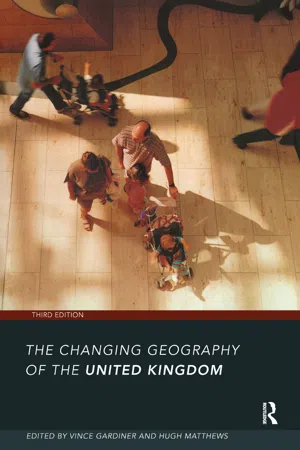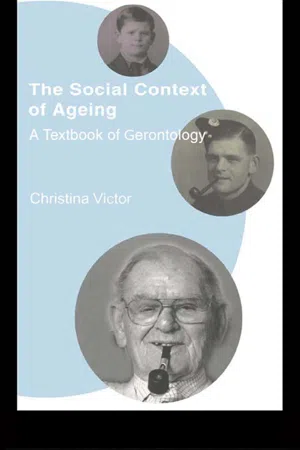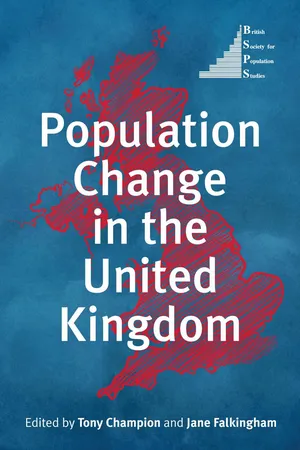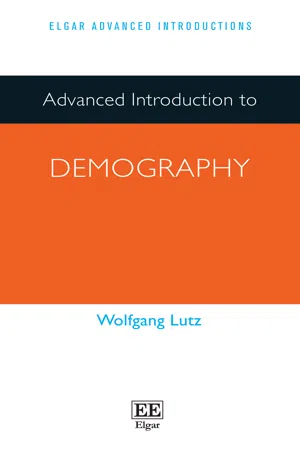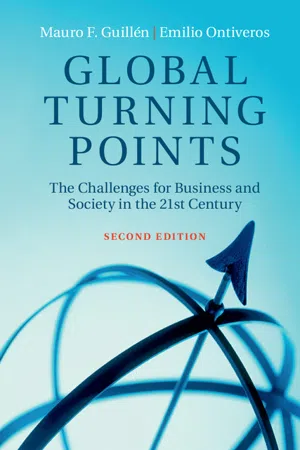Social Sciences
Demographic Trends UK
Demographic trends in the UK refer to the statistical changes in the population over time. This includes factors such as birth rates, death rates, immigration, and aging. Understanding these trends is important for policymakers, businesses, and organizations to plan for future needs in areas such as healthcare, education, and workforce development.
Written by Perlego with AI-assistance
Related key terms
1 of 5
7 Key excerpts on "Demographic Trends UK"
- eBook - ePub
- Keith Porter, Paul Smith, Roger Fagg(Authors)
- 2007(Publication Date)
- Routledge(Publisher)
Demographic and social trends
DOI: 10.4324/9780080492810-13Chapter objectives
In this chapter you will:- Evaluate the impact of demographic trends for markets for goods and services and for the labour market
- Consider the implications of demographic trends for government
- Review major social trends
- Consider changing social attitudes and the evolving social structure
- Assess the role played by organizations in shaping social tends and attitudes.
Chapter introduction
In this chapter we review a range of external environmental factors associated with social and cultural change. The issues and developments highlighted have major implications for corporate strategy. We begin by discussing the crucial importance of demographic change and continue with an assessment of the debate concerning social class. We then examine how changing attitudes impact on organizations.Case study
Table 13.1 PopulationUK population grows to 59.6 million
In 2003 the UK was home to 59.5 million people. This was an 18 per cent increase from 50.3 million in 1951, and a 3.2 per cent increase over the last decade (1993 to 2003). Until the mid-1990s, this growth was mainly due to natural increase as the number of births exceeded the number of deaths. Since the late 1990s, there has still been natural increase but net international migration into the UK from abroad has been an increasingly important factor in population growth (see Figure 13.1 ).Figure 13.1 Natural increase and net migration as components of population change, UK.In 2003, 84 per cent of the UK population were living in England, 8 per cent in Scotland, 5 per cent in Wales and 3 per cent in Northern Ireland (Table 13.1 - eBook - ePub
- Hugh Matthews, Vince Gardiner(Authors)
- 2020(Publication Date)
- Routledge(Publisher)
Chapter 9 Demography Tony Champion Introduction Demography provides an important backcloth to the developments taking place in the UK, but it is neither unchanging in its nature nor neutral in its effects. The term is used here to refer to the size, distribution and composition of the population and the patterns of life-course events which maintain or alter these, notably the three basic components of change in population numbers (births, deaths and migration), but also the many factors that affect household formation and family building. The demography of the UK has undergone some major changes over the past three decades, including greater longevity, lower fertility, higher divorce rate, accelerating cohabitation, later marriage and childbearing, increasing lone parenthood, larger numbers living alone, a fluctuating exodus from large cities, a switch from net emigration to substantial international migration gain and the rise of the UK’s non-white population. Each of these raises policy issues for society, most of them immediate and obvious in their implications but some with major long-term impacts such as the continuing passage of the 1960s/1970s baby boom and bust through the age structure. The significance of these trends is evident in many other parts of this book, including changes in labour supply (Chapter 8), increasing ethnic diversity of urban areas (Chapters 10, chapter 14), growing pressures on the countryside (Chapter 11), altered lifestyles and patterns of consumption (Chapters 12, chapter 13) and the greying of the electorate (Chapter 16). At the same time, a wide range of factors influences the course of population change itself, prompting demographers to stress that their attempts at looking into the future are essentially projections and not predictions - eBook - ePub
The Social Context of Ageing
A Textbook of Gerontology
- Christina Victor(Author)
- 2004(Publication Date)
- Routledge(Publisher)
Demography is concerned with describing, analysing and understanding trends in the structure of populations. In this context populations are usually defined in terms of nation-states as these are the units for which data are collected, but demographic analysis may be undertaken with various subsets of national populations such as regions, counties or specially constituted populations such as inner cities (or rural areas). The structure of a given population is rarely static as the relationship between the key drivers of demographic change; birth rates, death rates and migration are highly fluid and subject to considerable variation over time. It is the interaction between these three sets of factors that brings about demographic change. In the case of the United Kingdom, population ageing has largely come about because of changes in birth and death rates.The ageing of the British population
Perhaps the most striking demographic trend during the twentieth century in Britain, and many other parts of western Europe, has been the 'ageing' of the population. This refers to the processes of demographic change which results in an age structure which is characterised by increasing numbers (and percentages) of older people and decreasing numbers (and percentages) of younger people. Leaving aside the question of how precisely 'older' and 'younger' components of the population are defined, what are the processes which result in this demographic shift and what are the measures we use to describe the age profile of populations? Considering the processes that bring about population ageing, at the most basic level the distribution of age groups within any given population are function of mortality (death) rates and fertility rates. Population ageing occurs when large numbers of people survive into old age and comparatively few children are born.There are a number of different measures that are used to summarise the age distribution of populations. These are percentage population classed as 'old', mean and median ages, population pyramids, dependency ratio. We examine the factors involved in demographic ageing and the measures used to describe this in more detail by considering the changing nature of the population of Britain. - eBook - ePub
- Tony Champion, Jane Falkingham, Tony Champion, Jane Falkingham(Authors)
- 2016(Publication Date)
- Rowman & Littlefield Publishers(Publisher)
Over the next twenty-five years, we can say with a fair degree of certainty that the population will get larger, the population will get older and the population will become more diverse in terms of both ethnic composition and family forms. What is less clear is exactly how these changes will impact on particular places and alter their socio-demographic profiles, including whether urban-to-rural migration will pick up further as economic conditions improve, whether the dispersal of ethnic minority groups will accelerate and whether social segregation will intensify, all these being partly related to what long-term solution, if any, is found for the current ‘housing crisis’. The need to plan for this changing population remains as critical today as it did twenty-five years ago; so, too, does the need for better intelligence on how the UK’s population is altering over time, on what are the principal drivers of these changes and on what policy levers are likely to be more effective in encouraging the more welcome trends and counteracting the less desirable developments.The remaining chapters of this book aim to move forward our understanding of the UK’s changing demography and the opportunities and challenges that arise from this, building on the overview provided in the previous sections. The next two chapters focus on the ageing population, for which the trends appear highly predictable, though this does not diminish the scale of the implications for health and social care (Chapter 2 ), nor the challenge of ensuring well-being in the later stages of the life course for the many and not just the privileged few (Chapter 3 ). Attention then turns to the topic of immigration, which is sometimes seen as part of the solution to population ageing but which has much more uncertainty attached to it, in terms of both the numbers and the types of people that can be expected to arrive in any year and as regards their impacts on the economy and social relations (Chapter 4 ), but it seems that at least in one important respect, that of fertility and family size, there is evidence of convergence towards the national mean by the non-UK born and their descendants (Chapter 5 ).Chapters 6 and 7 focus on aspects relating to families and households, with the former taking a children’s perspective on the profound changes that have taken place in the structure of British families over recent decades and emphasising the wide diversity of conditions under which children grow up. These are reflected in similarly important changes in household composition and in the increasing difficulty that adults are facing in satisfying their housing needs and aspirations, with the cessation of the century-long decline in average household size, which seems at least partly due to shortages on the supply side (Chapter 7 ). The historically low levels of housebuilding in recent years can help to explain the reduction in frequency of moving home by almost all types of people apart from those of university age, including the fading of net north-to-south migration since the 1980s and the slowdown in the urban exodus since the early 2000s, with potential implications for the efficiency of housing and labour markets that merit further study (Chapter 8 ). For ethnic minorities, however, an accelerating dispersal from the original locales of immigrant settlement is a key change, though the main message of Chapter 9 - eBook - PDF
- H. Stephenson(Author)
- 2004(Publication Date)
- Palgrave Macmillan(Publisher)
My focus here is instead on the wider economic and social issues posed by demographic change, which I consider under four headings: 1. The demographic trends 2. The macroeconomic challenges 3. Immigration-based ‘solutions’ 4. Increasing birth rates. The demographic trends Future demographic trends are uncertain. We know what has happened to longevity and fertility in the past, but future projections are just projections. With United Nations estimates of global popula- tion in 2050 ranging from 7.4 billion to 10.6 billion, projections in this field come with big caveats. But, despite that warning, the direc- tion of the key trends – if not their precise pace – is fairly clear. In focusing on the impact of those trends, I shall be using the UN’s medium variant projection to illustrate my points. Europe’s demographics are changing as a result of three factors: first, increasing longevity; second, declining fertility; and, third, the existence of a ‘baby boom’ cohort, the generation born between about 1950 and 1970, which is larger than both the one before and the one that followed. My focus here is almost entirely on the first two factors and not on the baby boom, because it is these first two that define the long-term challenge for the whole world. The baby boom is important for spe- cific national pension systems over the next 20 to 30 years, because it makes changes in the ‘dependency ratio’ more rapid than those that would be produced by gradual and one-directional shifts in longevity and fertility. But my aim here is to look beyond the next 20 to 30 years in specific countries to the overall trends and implica- tions over, say, a 50-year period and at a global level. So what is happening to longevity and fertility? Longevity (life expectancy) is rising almost everywhere. Figure 7.1 shows how it has gone up in the UK throughout the twentieth century – rapidly in the first half, a slight deceleration in the 1950s and 1960s, acceleration since then. - eBook - PDF
- Wolfgang Lutz(Author)
- 2021(Publication Date)
- Edward Elgar Publishing(Publisher)
changes at the macro level, there has been a further loss in identity and sense of purpose. In an increasing number of academic settings around the world, demography, if represented at all, is considered a specific part of sociology or, alternatively, of public health rather than a distinct scientific discipline ADVANCED INTRODUCTION TO DEMOGRAPHY 30 in its own right. This is likely in part a consequence of the disregard given to genuine demographic theories. To contribute to changing this “trou- blesome” situation, in this chapter, three genuine demographic theories will be introduced and discussed: demographic metabolism, demographic transition and demographic dividend. This perceived loss of demographic identity stands in odd contrast to the increasing public perception that demographic change is one of the key megatrends of our times. In most industrialized countries around the world there are rising concerns about the effects of increasing proportions of the elderly on social security systems, of international migration on social cohesion and, in some cases, even about population decline. While in Africa and Western Asia there is still concern about rapid population growth, in Eastern Europe there now is a heightened fear of depopulation and national decline. In addition, the interactions between population change and climate change have become an important new topic of concern and research challenges for demography. But not many demog- raphers choose to focus on these big questions, although the questions are directly linked to the changing size and structures of populations and demography has a lot to contribute. Nathan Keyfitz, a giant in the field of mathematical demography and demographic thinking in the second half of the 20th century, tried to provoke change in this respect by stating that demography, far from being imperialistic, has withdrawn even from its own frontiers and left a no-man’s land which other disciplines have infiltrated. - eBook - PDF
Global Turning Points
The Challenges for Business and Society in the 21st Century
- Mauro F. Guillén, Emilio Ontiveros(Authors)
- 2016(Publication Date)
- Cambridge University Press(Publisher)
Moreover, demographic shifts will also shape attitudes and aspirations, individually and nationally (Howe and Jackson 2012 ). We will delve into these issues in Chapter 12 , paying attention to the different sources of geopolitical dominance, including soft and hard power. It is clear that the massive demographic changes described in this chapter will shape trends and events in the twenty-fi rst century. While we can use past experience and theoretical models to make predictions as to the nature and magnitude of the economic, social, political, cultural, and geopolitical consequences, it is always hard to envision the future from the vantage point of the present, especially in the case of demog-raphy. Above and beyond vital statistics, each generation experiences demographic circumstances in different ways and thus could react in different ways as well. Therefore, one should always take with a grain of salt not only predictions about demographic trends but also, and espe-cially, the consequences and the ultimate meaning of such predictions. For instance, the United Nations medium prediction is that the world ’ s total human population will exceed 10 billion towards the end of the twenty-fi rst century. However, this in no way necessarily means that there will not be enough food, water, energy, and natural resources for everyone to enjoy. Technological change, behavioral aspects related to consumption, and ef fi ciency enhancements in the use of scarce resources can help make ends meet. Population aging is one example of how important it is to be careful about the implications of demographic changes. It is important to distin-guish between cohort and life-course effects, that is, between characteris-tics intrinsic to a given age group (e.g., those who fought in World War II, the baby-boomers, generation Y, and so on), and changes in behavior over the course of one ’ s lifetime.
Index pages curate the most relevant extracts from our library of academic textbooks. They’ve been created using an in-house natural language model (NLM), each adding context and meaning to key research topics.

